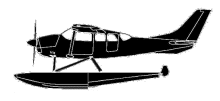
ASN Wikibase Occurrence # 284241
This information is added by users of ASN. Neither ASN nor the Flight Safety Foundation are responsible for the completeness or correctness of this information.
If you feel this information is incomplete or incorrect, you can submit corrected information.
| Date: | Friday 21 September 2007 |
| Time: | 14:00 LT |
| Type: |  Cessna U206 |
| Owner/operator: | Private |
| Registration: | N8030Z |
| MSN: | U206-0430 |
| Year of manufacture: | 1965 |
| Total airframe hrs: | 6527 hours |
| Engine model: | Continental IO-520 |
| Fatalities: | Fatalities: 0 / Occupants: 2 |
| Aircraft damage: | Substantial |
| Category: | Accident |
| Location: | McGrath, Alaska -
 United States of America United States of America
|
| Phase: | Unknown |
| Nature: | Ferry/positioning |
| Departure airport: | Galena Airport, AK (GAL/PAGA) |
| Moose Pass, AK (52Z) | |
| Investigating agency: | NTSB |
| Confidence Rating: |
The airline transport pilot, who was the company owner, and an aviation mechanic, was in cruise flight in a float-equipped airplane when he noticed an engine vibration, followed by a loud bang, and sudden stoppage of the propeller. The pilot described the prop as having suddenly stopped in a feathered position, without windmilling or slowing down. He selected an emergency landing area on a mountain ridge. Just prior to touchdown, the airplane collided with several trees, and nosed over. The pilot had requested and was granted a 100 hour extension beyond the engine overhaul interval of 1,700 hours by his FAA principle maintenance inspector (PMI). The pilot performed 25 hour oil changes and borescoped the engine pursuant to the granting of the 100 hour extension. The number 2 and 6 cylinders were changed about 173.6 hours before the accident, and the number 6 cylinder was changed again, about 60 hours before the accident. At the time of the accident, the engine had about 1,735 hours. Postaccident examination of the engine revealed that one of the number 4 cylinder rod cap bolts was bent 90 degrees, and the bolt threads had been stripped of its retaining nut. The loss of the nut allowed the rod cap to straighten, and then break the opposite cap bolt at its base. The entire number 4 piston and connecting rod departed the engine, breaking the number 4 cylinder away from the engine case. The propeller blade pitch change links within the hub were broken in tension, which the propeller manufacturer indicated was consistent with the blades contacting the ground or striking an object during the accident sequence.
Probable Cause: A separation of the engine connecting rod and engine cylinder due to the loss of a connecting rod nut that was stripped from the rod bolt.
Accident investigation:
 |
|
Sources:
NTSB ANC07LA104
History of this aircraft
Other occurrences involving this aircraft
| 8 October 1969 | N8030Z | Washington Aer | 0 | Paoli, IN |  |
w/o |
Revision history:
| Date/time | Contributor | Updates |
|---|---|---|
| 30-Sep-2022 13:48 | ASN Update Bot | Added |
Corrections or additions? ... Edit this accident description
The Aviation Safety Network is an exclusive service provided by:


 ©2024 Flight Safety Foundation
©2024 Flight Safety Foundation